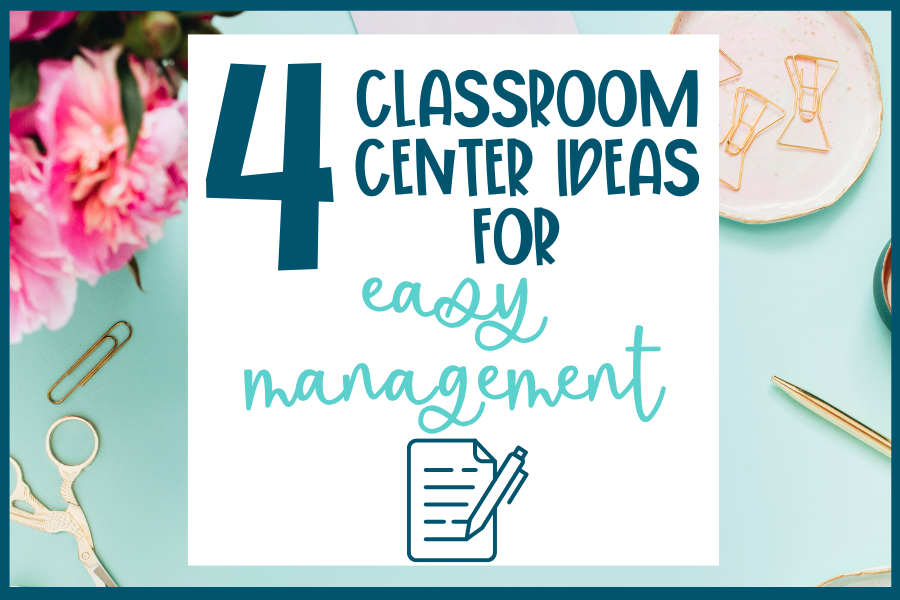Classroom center rotations are a great way to incorporate learning in a fun way, provide an opportunity for students to work together, and allow you the ability to work with students in a small group setting. However, creating a successful and effective center rotation time in your classroom can feel daunting. The good news is it can be done. You can have a center time that is easy to manage and an effective learning time for your students. Here are 4 easy to implement strategies to make your classroom centers ideas easier to manage.
Management of Classroom Centers Ideas
You may have a ton of classroom centers ideas in your mind, but when it comes to a kindergarten classroom or any classroom, trying to figure out all of the management points can be exhausting. You’re not only managing small group instruction but also the learning stations, technology stations, and more! So, how can you implement all the classroom centers ideas you know your students will love? Follow these 4 strategies.
Center Rotation Display

Having a center rotation display, such as a Daily 5 or math center image, is a great way to keep your classroom organized and ensure that students know exactly where to go. By displaying rotations in a clear, easy-to-understand format, students can follow the schedule without needing constant reminders. Including timers in your display helps you stay on track and allows students to manage their time more effectively and stay accountable, whether they’re working in small groups or independently. This setup minimizes the need to repeat instructions, creating a smoother and more efficient classroom routine.
Routine Centers

One of the benefits of having routine centers in the classroom is that the instructions stay the same, but the skill changes weekly based on what you’re focusing on. This consistency helps students feel confident with what they are expected to do after a few weeks of practice, leading to fewer questions and interruptions during your small group or teacher table time. Plus, it saves you from having to explain new centers every week.
For example, in my word work center, I use mystery picture puzzles. With over 80 puzzles, there are enough skills to last the entire year. Students read the words on the cards and match them to the correct picture, and I included an optional recording sheet for them to note what the mystery picture was.
By keeping centers consistent, such as my ELA setup—two reading centers (read to self and buddy reading), word work, writing, technology, and teacher table time—students know what to expect, making center time run smoother. The word work center stays the same all year, with minimal changes, while the teacher table adjusts weekly based on the needs of my small groups.
Organization is Important
Organization is key not only to the success of students but also to your ability to effectively manage center time. The last thing you want is to be scrambling around, trying to figure out what centers to set up, making or finding misplaced centers, and dealing with the chaos that comes with it. This not only overwhelms you but also opens the door for student misbehavior.
By having centers organized in binders or bins, using routine centers you can practically set on autopilot, maintaining an organized display for students to reference, and keeping a recording sheet for tracking data, you can keep everything running smoothly. Plus, when everything is in its place, students can help out by getting out and putting away materials since they know exactly where things belong.
Practice Center Expectations
For your center rotations to be successful, it’s essential that students clearly understand your expectations. Displaying these expectations for each center and reviewing them with students regularly is key to maintaining smooth transitions and productive center time. While it’s ideal to set these expectations early in the year, it’s never too late to revisit and reinforce them.
Take time to review each center’s guidelines and give students opportunities to practice. During this process, hold off on leading a teacher table group—still pull students to your table but provide them with independent tasks—so you can focus on monitoring the room. Model the behavior you expect and redirect students when necessary.

Once they consistently meet expectations, you’ll feel confident running your own center, knowing the rest of the room is on track. Be sure also to establish the rules for the teacher’s table, making it clear that students should respect your time with that group and only interrupt in emergencies. If students aren’t adhering to expectations, don’t hesitate to pause teacher table activities and revisit the procedures. Taking the time to practice will pay off, as will ensuring your center time is productive, and your teacher table sessions remain focused on the group at hand.
Centers can be a fun learning environment for students that is also extremely effective in the learning process because it incorporates fun, teamwork, independence, and learning all together. Don’t let centers become so overwhelming that you give up on them. Instead, use these strategies to help manage your center time so that it is effective and efficient.



